AMD Ryzen 9 5980HS Cezanne Review: Ryzen 5000 Mobile Tested
by Dr. Ian Cutress on January 26, 2021 9:00 AM EST- Posted in
- CPUs
- AMD
- Vega
- Ryzen
- Zen 3
- Renoir
- Notebook
- Ryzen 9 5980HS
- Ryzen 5000 Mobile
- Cezanne
CPU Tests: Simulation
Simulation and Science have a lot of overlap in the benchmarking world, however for this distinction we’re separating into two segments mostly based on the utility of the resulting data. The benchmarks that fall under Science have a distinct use for the data they output – in our Simulation section, these act more like synthetics but at some level are still trying to simulate a given environment.
DigiCortex v1.35: link
DigiCortex is a pet project for the visualization of neuron and synapse activity in the brain. The software comes with a variety of benchmark modes, and we take the small benchmark which runs a 32k neuron/1.8B synapse simulation, similar to a small slug.
The results on the output are given as a fraction of whether the system can simulate in real-time, so anything above a value of one is suitable for real-time work. The benchmark offers a 'no firing synapse' mode, which in essence detects DRAM and bus speed, however we take the firing mode which adds CPU work with every firing.
The software originally shipped with a benchmark that recorded the first few cycles and output a result. So while fast multi-threaded processors this made the benchmark last less than a few seconds, slow dual-core processors could be running for almost an hour. There is also the issue of DigiCortex starting with a base neuron/synapse map in ‘off mode’, giving a high result in the first few cycles as none of the nodes are currently active. We found that the performance settles down into a steady state after a while (when the model is actively in use), so we asked the author to allow for a ‘warm-up’ phase and for the benchmark to be the average over a second sample time.
For our test, we give the benchmark 20000 cycles to warm up and then take the data over the next 10000 cycles seconds for the test – on a modern processor this takes 30 seconds and 150 seconds respectively. This is then repeated a minimum of 10 times, with the first three results rejected. Results are shown as a multiple of real-time calculation.
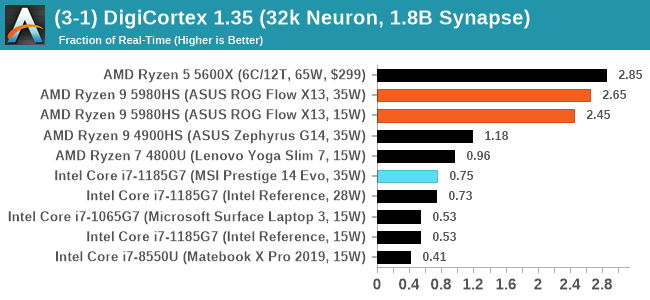
DigiCortex seems to have taken a shine to Zen 3, especially processors with a single chiplet of cores. Intel can't seem to compete here.
Dwarf Fortress 0.44.12: Link
Another long standing request for our benchmark suite has been Dwarf Fortress, a popular management/roguelike indie video game, first launched in 2006 and still being regularly updated today, aiming for a Steam launch sometime in the future.
Emulating the ASCII interfaces of old, this title is a rather complex beast, which can generate environments subject to millennia of rule, famous faces, peasants, and key historical figures and events. The further you get into the game, depending on the size of the world, the slower it becomes as it has to simulate more famous people, more world events, and the natural way that humanoid creatures take over an environment. Like some kind of virus.
For our test we’re using DFMark. DFMark is a benchmark built by vorsgren on the Bay12Forums that gives two different modes built on DFHack: world generation and embark. These tests can be configured, but range anywhere from 3 minutes to several hours. After analyzing the test, we ended up going for three different world generation sizes:
- Small, a 65x65 world with 250 years, 10 civilizations and 4 megabeasts
- Medium, a 127x127 world with 550 years, 10 civilizations and 4 megabeasts
- Large, a 257x257 world with 550 years, 40 civilizations and 10 megabeasts
DFMark outputs the time to run any given test, so this is what we use for the output. We loop the small test for as many times possible in 10 minutes, the medium test for as many times in 30 minutes, and the large test for as many times in an hour.
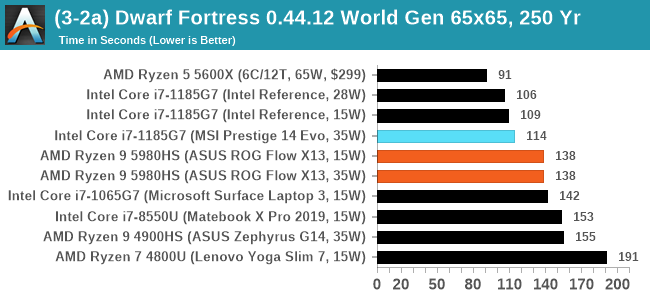
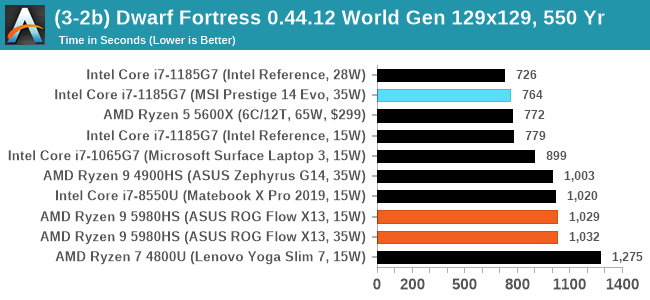
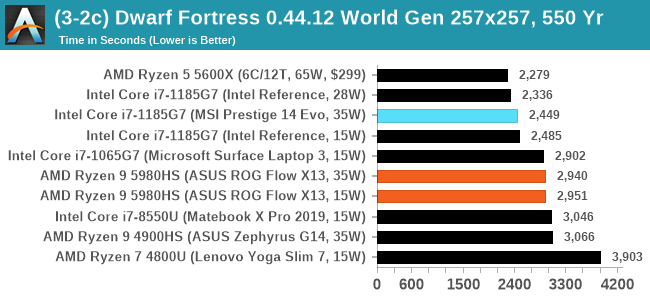
DF has historically been an Intel favorite, and we're not seeing much of a speedup for mobile Zen 3 over mobile Zen 2 here.
Dolphin v5.0 Emulation: Link
Many emulators are often bound by single thread CPU performance, and general reports tended to suggest that Haswell provided a significant boost to emulator performance. This benchmark runs a Wii program that ray traces a complex 3D scene inside the Dolphin Wii emulator. Performance on this benchmark is a good proxy of the speed of Dolphin CPU emulation, which is an intensive single core task using most aspects of a CPU. Results are given in seconds, where the Wii itself scores 1051 seconds.
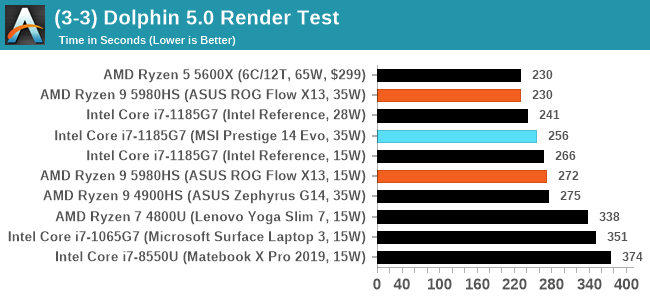
The 35W variant of Cezanne pushes through here, matching the desktop processor, and a sizeable performance jump over the previous generation Renoir.












218 Comments
View All Comments
vladx - Wednesday, January 27, 2021 - link
What? Since Thunderbolt 3 has a 40Gbps bandwidth it is absolutely not "only using 4 PCIe 3.0 lanes on PCs that have Titan Ridge controllers.Spunjji - Thursday, January 28, 2021 - link
The short answer is: yes, it is.The long answer is:
https://www.techspot.com/review/2104-pcie4-vs-pcie...
Tams80 - Monday, February 1, 2021 - link
8x will be enough. It should only be a 2-3% drop in performance.Of course 16x would be nice, but I don't think OCuLink is available as that.
Fulljack - Wednesday, January 27, 2021 - link
the FP5 package used by AMD mobile processor only allows PCIe 3.0 x8 connection to dGPU, but you still have extra x4/x4 connection for I/O and storage.when moving to AM4, desktop Renoir still have the same PCIe lanes as Matisse, that is 16+4+4 lanes.
it's not a problem since TB3 eGPU are using PCIe 3.0 x4 anyway.
nils_ - Wednesday, January 27, 2021 - link
I was wondering about that as well, it also seems a bit confusing with Tiger Lake (is it 4 or 8 lanes of PCIe 4.0?). The advantage with Tiger Lake is that it has TB4 integrated in the SoC, unfortunately I haven't seen any AMD based laptop with TB so far so I went with Intel to keep my docking station(s). Maybe this time around there will be a model foregoing the dGPU for a TB controller.Spunjji - Thursday, January 28, 2021 - link
TL has 4 lanes of PCIe 4.0Spunjji - Thursday, January 28, 2021 - link
"I've been seeing reports of it only having x8 PCIe 3.0 lanes, which could present a problem to AMD's apparent goal of pairing Cezanne with discrete GPUs."Nope. See all the announced devices with Cezanne and RTX 3070 or 3080 GPUs.
It was never a problem with Renoir, either. People just came up with post-hoc rationalizations for why Intel still dominated gaming laptops despite having an inferior CPU.
ottonis - Tuesday, January 26, 2021 - link
The mobile Zen3 CPUs are a great generational update. Glad to see a healthy increase in new design wins and one can only hope that AMD will be able to deliver all these CPUs to the OEMs in sufficient quantities so these notebooks will be available to the consumer.That being said, the true challenge is Apple Silicon. While AMD can beat the M1 CPU in multi core tasks, Apple will outclass everything x86 once they introduce their second gen silicon with much higher core count and other architectural improvements.
So, I wonder what kind of strategy AMD (and Intel) will follow in the near future. I remember - maybe ~10+y ago - when AMD had some sort of transient partnership with ARM and everybody thought AMD would somehow implement ARM designs into some sort of hybride chip. For some reasons that never came to fruition.
In order to stay relevant in the mobile (and desktop) CPU market, AMD will have to react to the huge attack from Apple silicon in one way or another. So, what does AMD have up their sleeves?
Intel is apparently going the big.little route in their next generation of mobile CPUs with little Atom-based cores and big performance cores. I am curious what AMD is up to.
JfromImaginstuff - Tuesday, January 26, 2021 - link
Well about AMD's relationship with arm, they have an arm license, so does Intel for that matter. So if x86 starts going south, AMD will almost certainly abandon it, and Intel most likely will do so as well especially with their new CEO.Deicidium369 - Wednesday, January 27, 2021 - link
LOL - Gelsinger's great grand kids will be on Social Security before that happens